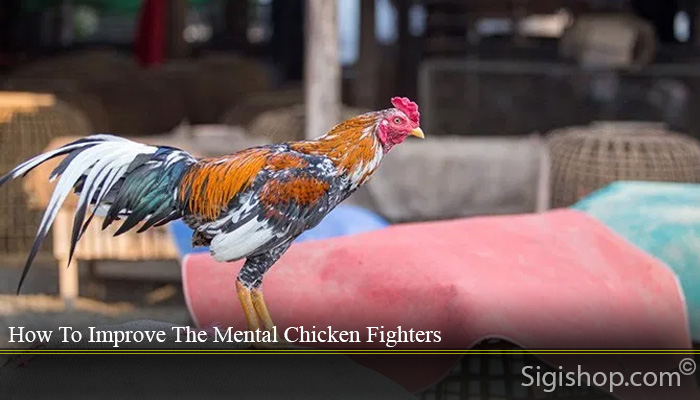How To Improve The Mental Chicken Fighters
 How To Improve The Mental Chicken Fighters
How To Improve The Mental Chicken Fighters
Discussion About How To Improve The Mental Chicken Fighters Strong courage is the main capital for fighting chickens to be able to defeat the opponent. Chickens who have high courage and endure pain will make the opponent’s mental down when pitted. When the opponent’s mental down, the opponent will be easier to defeat.
Now, realizing that brave mentality for chickens is very supportive for his victory on the battlefield, so as a guide we must be able to train that courage to emerge from him. Based on my experience, brave mentality in chickens can be trained in several ways. What are some ways to increase courage in Bangkok chicken that you can do? Following below, we will directly discuss some guidelines on how to improve the mental chicken fighters :
• How to Improve Brave Mentality in Bangkok Chickens
The only way that can be done to train courage in bangkok chickens is to do a fighting jajal. Even so, we cannot do fighting on bangkok chickens to be trained with just any opponent.
There are special rules that must be applied so that fighting practice produces optimal mental changes. You must choose a fighting opponent who has an advantage. Here are the types of fighting opponents that I recommend to train mentally brave in your fighting chickens.
➢ 1. Try fighting with hard-hitting chickens
So that courage increases, the chicken can be matched with other chickens that have a hard blow. Even so, you have to make sure that the opposing chicken is technically fighting with your chicken so that your chicken doesn’t get hurt.
When trained to fight with hard-hitting chickens routinely, your chicken body will be trained to take blows. Naturally, every hard hit from an opposing chicken will make your chicken muscles become harder and more resistant to blows. Chickens that have often been hit hard or very hard will increase their courage. There were no more enemies to fear. Characteristics of hard-beating chickens include small feet with merit fingers.
➢ 2. Try Fighting with More Aggressive Chickens
If the mental training of chickens is good enough, it is better to choose opponents who train more aggressively. However, if your chicken is mentally classified as very bad, then the chicken should not be matched with a more aggressive chicken. This can cause chickens to be trained instead of getting bolder, instead they become afraid. Chickens that have dared to fight aggressive chickens, will be mentally better. He will not give up easily even though he found a heavy opponent in the actual fight.
➢ 3. Try fighting with older chickens
Older chickens will usually frighten younger chickens. If a trained chicken is brave enough to face an older opponent, especially if he can defeat him, his mentality and courage will greatly increase.
Also Read : How To Practice Fighting Techniques And Breathing Chickens
Mental and courage fighting chickens are the most important by fighting chickens. Because both are considered as the main weapons for the chicken to win the game and become champions. When doing an abar certainly we have been confronted with the problem of chickens who have not dared to fight.
Generally, mentally normal chickens will begin to appear at the age of seven months, but many fighters who have more than seven months, have a large body and healthy but do not have a fighter mentality. Therefore, as a guide, you should find a way to solve this problem.
Keep in mind there are several factors that cause why young chickens do not have the mentality to fight. Among them are heredity, since childhood is always bullied by other chickens, chickens traumatized by other animal disorders such as dogs, and environmental conditions that are less comfortable for chickens.
• Chicken Should Be Separated
Separation can be done by placing chickens in cages that are different from one another. This aims to reduce the risk of young chickens fighting with other chickens.
When mixed in one cage, most chickens that have good mentality will bully chickens that have a weak mentality so that weak chickens become accustomed to yield and do not dare to fight. Ironically, this habit of succumbing can have a bad impact, for example, when chickens are pitted, chickens will run away and do not want to fight.
• Give Herbal Medicine
Many term the chicken that has no mentality with “the chicken does not have a heart”. Actually what is meant is that chickens have problems in their internal organs, especially the liver, so chickens are reluctant to fight.
The most effective way to overcome this problem is to provide herbal medicine. This herbal concoction can be made with natural ingredients such as turmeric, honey, brown sugar and others that are useful for chicken stamina.
• Give Supplements in the form of Live Animals
There have been many botoh who provide live animal feed to make fighter chickens more aggressive. The animals in question are crickets, cubs and frogs. Chicken should be left to eat by chasing its prey, then so little by little the chicken will improve mentally.
• Chickens are put into Isolation Cages
The purpose of isolation cages is for young chickens who are mentally damaged completely. Examples of chickens that have been completely damaged mentally is where the chicken has no desire to fight, even with a hen or a younger chicken is not brave.
Isolation cage is a cage that is closed and not affordable by other chickens. The aim of the chicken is put into isolation cages so that the mentally weak chickens can recover after being removed because it has been a long time since they have seen other chickens and usually only within a few weeks the previously lethargic chickens have started crowing.
